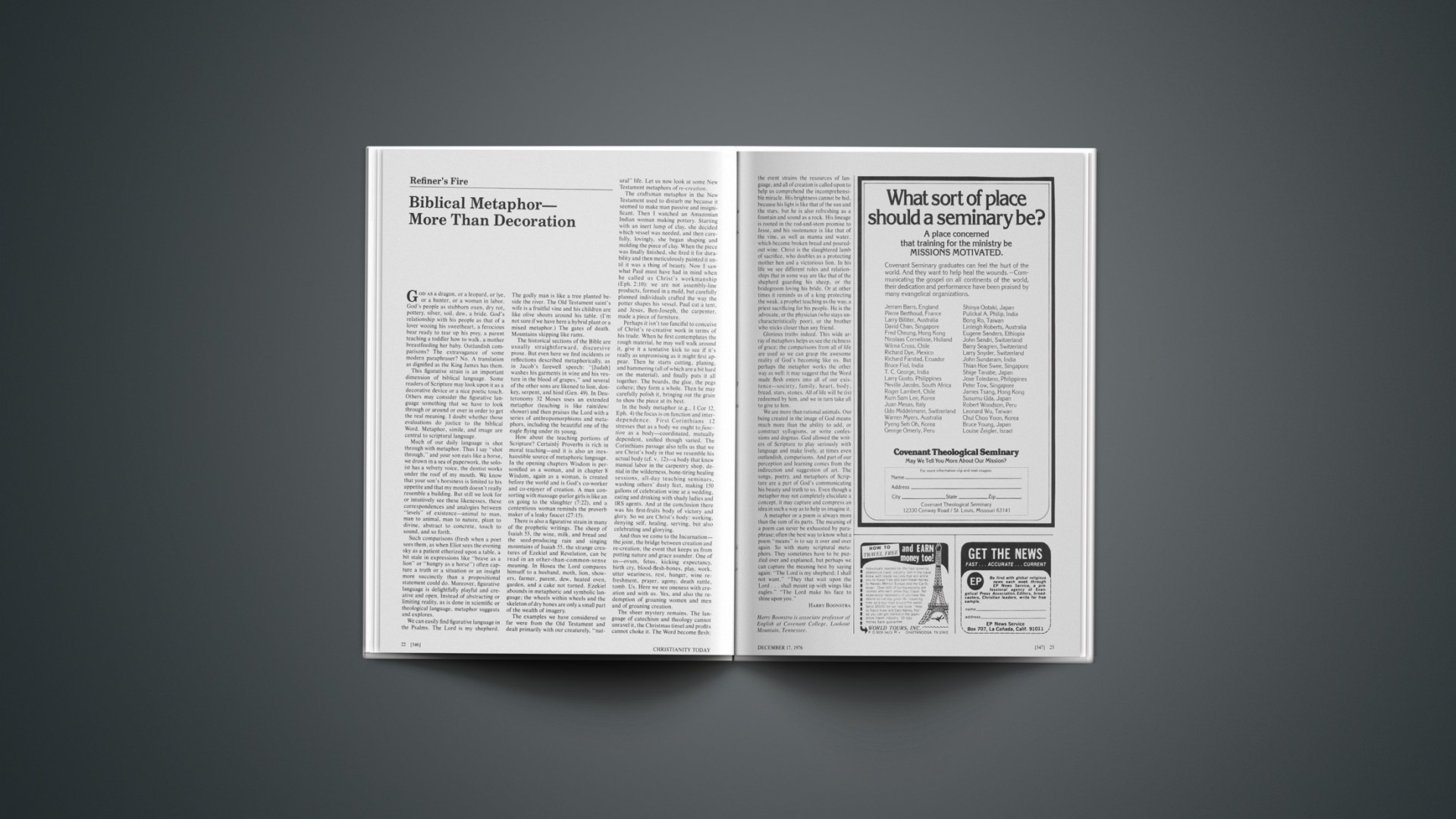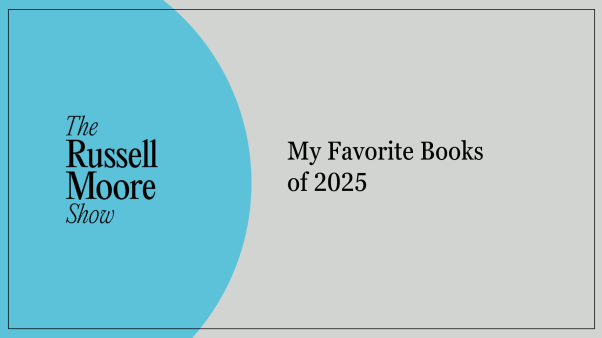God as a dragon, or a leopard, or lye, or a hunter, or a woman in labor. God’s people as stubborn oxen, dry rot, pottery, silver, soil, dew, a bride. God’s relationship with his people as that of a lover wooing his sweetheart, a ferocious bear ready to tear up his prey, a parent teaching a toddler how to walk, a mother breastfeeding her baby. Outlandish comparisons? The extravagance of some modern paraphraser? No. A translation as dignified as the King James has them.
This figurative strain is an important dimension of biblical language. Some readers of Scripture may look upon it as a decorative device or a nice poetic touch. Others may consider the figurative language something that we have to look through or around or over in order to get the real meaning. I doubt whether those evaluations do justice to the biblical Word. Metaphor, simile, and image are central to scriptural language.
Much of our daily language is shot through with metaphor. Thus I say “shot through,” and your son eats like a horse, we drown in a sea of paperwork, the soloist has a velvety voice, the dentist works under the roof of my mouth. We know that your son’s horsiness is limited to his appetite and that my mouth doesn’t really resemble a building. But still we look for or intuitively see these likenesses, these correspondences and analogies between “levels” of existence—animal to man, man to animal, man to nature, plant to divine, abstract to concrete, touch to sound, and so forth.
Such comparisons (fresh when a poet sees them, as when Eliot sees the evening sky as a patient etherized upon a table, a bit stale in expressions like “brave as a lion” or “hungry as a horse”) often capture a truth or a situation or an insight more succinctly than a propositional statement could do. Moreover, figurative language is delightfully playful and creative and open. Instead of abstracting or limiting reality, as is done in scientific or theological language, metaphor suggests and explores.
We can easily find figurative language in the Psalms. The Lord is my shepherd. The godly man is like a tree planted beside the river. The Old Testament saint’s wife is a fruitful vine and his children are like olive shoots around his table. (I’m not sure if we have here a hybrid plant or a mixed metaphor.) The gates of death. Mountains skipping like rams.
The historical sections of the Bible are usually straightforward, discursive prose. But even here we find incidents or reflections described metaphorically, as in Jacob’s farewell speech: “[Judah] washes his garments in wine and his vesture in the blood of grapes,” and several of the other sons are likened to lion, donkey, serpent, and hind (Gen. 49). In Deuteronomy 32 Moses uses an extended metaphor (teaching is like rain/dew/shower) and then praises the Lord with a series of anthropomorphisms and metaphors, including the beautiful one of the eagle flying under its young.
How about the teaching portions of Scripture? Certainly Proverbs is rich in moral teaching—and it is also an inexhaustible source of metaphoric language. In the opening chapters Wisdom is personified as a woman, and in chapter 8 Wisdom, again as a woman, is created before the world and is God’s co-worker and co-enjoyer of creation. A man consorting with massage-parlor girls is like an ox going to the slaughter (7:22), and a contentious woman reminds the proverb maker of a leaky faucet (27:15).
There is also a figurative strain in many of the prophetic writings. The sheep of Isaiah 53, the wine, milk, and bread and the seed-producing rain and singing mountains of Isaiah 55, the strange creatures of Ezekiel and Revelation, can be read in an other-than-common-sense meaning. In Hosea the Lord compares himself to a husband, moth, lion, showers, farmer, parent, dew, heated oven, garden, and a cake not turned. Ezekiel abounds in metaphoric and symbolic language; the wheels within wheels and the skeleton of dry bones are only a small part of the wealth of imagery.
The examples we have considered so far were from the Old Testament and dealt primarily with our creaturely, “natural” life. Let us now look at some New Testament metaphors of re-creation.
The craftsman metaphor in the New Testament used to disturb me because it seemed to make man passive and insignificant. Then I watched an Amazonian Indian woman making pottery. Starting with an inert lump of clay, she decided which vessel was needed, and then carefully, lovingly, she began shaping and molding the piece of clay. When the piece was finally finished, she fired it for durability and then meticulously painted it until it was a thing of beauty. Now I saw what Paul must have had in mind when he called us Christ’s workmanship (Eph. 2:10): we are not assembly-line products, formed in a mold, but carefully planned individuals crafted the way the potter shapes his vessel, Paul cut a tent, and Jesus, Ben-Joseph, the carpenter, made a piece of furniture.
Perhaps it isn’t too fanciful to conceive of Christ’s re-creative work in terms of his trade. When he first contemplates the rough material, he may well walk around it, give it a tentative kick to see if it’s really as unpromising as it might first appear. Then he starts cutting, planing, and hammering (all of which are a bit hard on the material), and finally puts it all together. The boards, the glue, the pegs cohere; they form a whole. Then he may carefully polish it, bringing out the grain to show the piece at its best.
In the body metaphor (e.g., 1 Cor 12; Eph. 4) the focus is on function and interdependence. First Corinthians 12 stresses that as a body we ought to function as a body—coordinated, mutually dependent, unified though varied. The Corinthians passage also tells us that we are Christ’s body in that we resemble his actual body (cf. v. 12)—a body that knew manual labor in the carpentry shop, denial in the wilderness, bone-tiring healing sessions, all-day teaching seminars, washing others’ dusty feet, making 150 gallons of celebration wine at a wedding, eating and drinking with shady ladies and IRS agents. And at the conclusion there was his first-fruits body of victory and glory. So we are Christ’s body: working, denying self, healing, serving, but also celebrating and glorying.
And thus we come to the Incarnation—the joint, the bridge between creation and re-creation, the event that keeps us from putting nature and grace asunder. One of us—ovum, fetus, kicking expectancy, birth cry, blood-flesh-bones, play, work, utter weariness, rest, hunger, wine refreshment, prayer, agony, death rattle, tomb. Us. Here we see oneness with creation and with us. Yes, and also the redemption of groaning women and men and of groaning creation.
The sheer mystery remains. The language of catechism and theology cannot unravel it, the Christmas tinsel and profits cannot choke it. The Word become flesh: the event strains the resources of language, and all of creation is called upon to help us comprehend the incomprehensible miracle. His brightness cannot be hid, because his light is like that of the sun and the stars, but he is also refreshing as a fountain and sound as a rock. His lineage is rooted in the rod-and-stem promise to Jesse, and his sustenance is like that of the vine, as well as manna and water, which become broken bread and poured-out wine. Christ is the slaughtered lamb of sacrifice, who doubles as a protecting mother hen and a victorious lion. In his life we see different roles and relationships that in some way are like that of the shepherd guarding his sheep, or the bridegroom loving his bride. Or at other times it reminds us of a king protecting the weak, a prophet teaching us the way, a priest sacrificing for his people. He is the advocate, or the physician (who stays uncharacteristically poor), or the brother who sticks closer than any friend.
Glorious truths indeed. This wide array of metaphors helps us see the richness of grace; the comparisons from all of life are used so we can grasp the awesome reality of God’s becoming like us. But perhaps the metaphor works the other way as well: it may suggest that the Word made flesh enters into all of our existence—society, family, heart, body, bread, stars, stones. All of life will be (is) redeemed by him, and we in turn take all to give to him.
We are more than rational animals. Our being created in the image of God means much more than the ability to add, or construct syllogisms, or write confessions and dogmas. God allowed the writers of Scripture to play seriously with language and make lively, at times even outlandish, comparisons. And part of our perception and learning comes from the indirection and suggestion of art. The songs, poetry, and metaphors of Scripture are a part of God’s communicating his beauty and truth to us. Even though a metaphor may not completely elucidate a concept, it may capture and compress an idea in such a way as to help us imagine it.
A metaphor or a poem is always more than the sum of its parts. The meaning of a poem can never be exhausted by paraphrase; often the best way to know what a poem “means” is to say it over and over again. So with many scriptural metaphors. They sometimes have to be puzzled over and explained, but perhaps we can capture the meaning best by saying again: “The Lord is my shepherd; I shall not want.” “They that wait upon the Lord … shall mount up with wings like eagles.” “The Lord make his face to shine upon you.”
Harry Boonstra is associate professor of English at Covenant College, Lookout Mountain, Tennessee.








